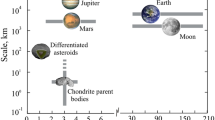Abstract
Terrestrial planets are accreted in a disk orbiting a central star. The basic challenge of their formation consists of assembling micron-sized or smaller dust grains to bodies with over 104 km in diameter. This formation process, ultimately based on collisions, occurs in three very different physical regimes depending upon the size of the bodies present: 1) Early on, micron- to mm-sized dust grains, chondrules and chondrites are strongly coupled to the gas. 2) As they grow larger, gravity increases the collisional cross section allowing runaway growth to occur. 3) After this runaway phase stops from exhaustion of matter in the immediate surroundings of the protoplanets, further growth occurs on timescales typical of mutual gravitational perturbations. The emphasis of this book is on the timescales corresponding to these formation phases as well as the characteristic chemical and isotopic composition of the bodies involved.
Similar content being viewed by others
References
Adams, F.C., and Laughlin, G.: 2000, 'Protostellar Disk Formation and Early Evolution', this volume.
Artymowicz, P.: 2000, 'Beta Pictoris and Other Solar Systems', this volume.
Balbus, S. A., and Hawley, J. F.: 2000, 'Solar Nebula Magnetohydrodynamics', this volume.
Benz, W.: 2000, 'Low Velocity Collisions and Growth of Planetesimals', this volume.
Blum, J.: 2000, 'Laboratory Experiments on Preplanetary Dust Aggregation', this volume.
Bochsler, P., and Kallenbach, R.: 1994, 'Fractionation of Nitrogen Isotopes in Solar Energetic Particles', Meteoritics 29, 653–658.
Boss, A. P., and Vanhala, H. A. T.: 2000, 'Triggering Protostellar Collapse, Injection, and Disk Formation', this volume.
Brandenburg, A., Nordlund, A., Stein, R. F., and Torkelsson, U.: 1996, 'The Disk Accretion Rate for Dynamo-generated Turbulence', Astrophys. J. 458, L45–L49.
Cassen, P.: 1994, 'Utilitarian Models of the Solar Nebula', Icarus 112, 405–429.
Cellino, A.: 2000, 'Minor Bodies: Spectral Gradients and Relationships With Meteorites', this volume.
Drouart, A., Dubrulle, B., Gautier, D., and Robert, F.: 1999, 'Structure and Transport in the Solar Nebula From Constraints on Deuterium Enrichment and Giant Planet Formation', Icarus 140, 129–155.
Fegley, B., Jr.: 2000, 'Kinetics of Gas-grain Reactions in the Solar Nebula', this volume.
Fisk, L. A.: 1978, 'He-3-rich Flares – A Possible Explanation', Astrophys. J. 224, 1048–1055.
Frank, A., and Mellema, G.: 1994, 'A Radiation-Gasdynamical Method for Numerical Simulations of Ionized Nebulae: Radiation-Gasdynamics of PNe I', Astron. Astrophys. 289, 937–945.
Foster, P. N., and Boss, A. P.: 1996, 'Triggering Star Formation with Stellar Ejecta, Astrophys. J. 468, 784–796.
Gilmour, J. D.: 2000, 'The Extinct Radionuclide Timescale of the Early Solar System', this volume.
Goodman, A., Benson, P., Fuller, G., and Myers, P.: 1993, 'Dense Cores in Dark Clouds – VIII. Velocity gradients', Astrophys. J. 406, 528–547.
Halliday, A. N.: 2000, 'Hf–W Chronometry and Inner Solar System Accretion Rates', this volume.
Hartmann, L.: 2000, 'Observational Constraints on Transport (and Mixing) in Pre-main Sequence Disks', this volume.
Lizano, S., and Shu, F. H.: 1989, 'Molecular Cloud Cores and Bimodal Star Formation', Astrophys. J. 342, 834–854.
Lodders, K.: 2000, 'An Oxygen Isotope Mixing Model for the Accretion and Composition of Rocky Planets', this volume.
Lugmair, G. W., and Shukolyukov, A.: 1998, 'Early Solar System Timescales According to 53Mn-53Cr Systematics', Geochim. Cosmochim. Acta 62, 2863–2886.
Meyer, B., and Clayton, D. D.: 2000, 'Short-lived Radioactivities and the Birth of the Sun', this volume.
Mouschovias, T. Ch.: 1991, 'Magnetic Braking, Ambipolar Diffusion, Cloud Cores, and Star Formation: Natural Length Scales and Protostellar Masses', Astrophys. J. 373, 169–186.
Nichols, R. H., Jr.: 2000, 'Short-lived Radionuclides in Meteorites: Constraints on Nebular Timescales for the Production of Solids', this volume.
Palme, H.: 2000, 'Are There Chemical Gradients in the Inner Solar System?', this volume.
Pepin, R. O.: 2000, 'On the Isotopic Composition of Primordial Xenon in Terrestrial Planet Atmospheres', this volume.
Robert, F.: 2000, 'The Solar System D/H Ratio: Observations and Theories', this volume.
Rodriguez, L. F., D'Alessio, P., Wilner, D. J., Ho, P.T.P., Torrelles, J.M., Curiel, S., Gomez, Y., Lizano, S., Pedlar, A., Cantó, J., and Raga, A.C.: 1998, 'Compact Protoplanetary Disks Around the Stars of a Young Binary System', Nature 395, 355–357.
Roth, I., and Temerin, M.: 1997, 'Enrichment of 3He and Heavy Ions in Impulsive Solar Flares', Astrophys. J. 477, 940–957.
Shang, H., Shu, F. H., Lee, T., and Glassgold, A. E.: 2000, 'Protostellar Winds and Chondritic Meteorites', this volume.
Shu, F.H., Adams, F.C., and Lizano, S.: 1987, 'Star Formation in Molecular Clouds: Observation and Theory', Ann. Rev. Astron. Astrophys. 25, 23–72.
Shu, F.H., Shang, H., and Lee, T.: 1996, 'Toward an Astrophysical Theory of Chondrites', Science 271, 1545–1552.
Shu, F.H., Shang, H., Glassgold, A. E., and Lee, T.: 1997, 'X-rays and Fluctuating X-winds From Protostars', Science 277, 1475–1479.
Shukolyukov, A., and Lugmair, G.: 2000, 'On the 53Mn Heterogeneity in the Early Solar Nebula', this volume.
Sugiura, N., and Strangway, D.W.: 1988, 'Magnetic Studies of Meteorites', in J. F. Kerridge, and M. S. Matthews (eds.), Meteorites and the Early Solar System, University of Arizona Press, Tucson, pp. 595–615.
Terquem, C., Papaloizou, J.C.B., and Nelson, R. P.: 2000, 'Disks, Extrasolar Planets, and Migration', this volume.
Texeira, T. C., Devlin, G. P., Bush, G., and Emerson, J. P.: 1999, 'Discovery of Solid HDO in Grain Mantles', Astrophys. J. 347, L19–L22.
Weidenschilling, S. J.: 'Formation of Planetesimals and Accretion of the Terrestrial Planets', this volume.
Wetherill, G.W., and Inaba, S.: 2000, 'Planetary Accumulation With a Continuous Supply of Planetesimals', this volume.
Williams, D. L., Leske, R. A., Mewaldt, R.A., and Stone, E.C.: 1998, 'Solar Energetic Particle Isotopic Composition', Space Sci. Rev. 85, 379–386.
Wood, J.A.: 2000a, 'Temperature and Pressure Gradients in the Solar Nebula', this volume.
Wood, J.A.: 2000b, 'The Beginning: Swift and Violent', this volume.
Author information
Authors and Affiliations
Rights and permissions
About this article
Cite this article
Kallenbach, R., Benz, W. & Lugmair, G.W. From Dust to Terrestrial Planets – Introduction. Space Science Reviews 92, 1–10 (2000). https://doi.org/10.1023/A:1005295830920
Issue Date:
DOI: https://doi.org/10.1023/A:1005295830920




